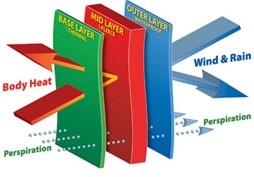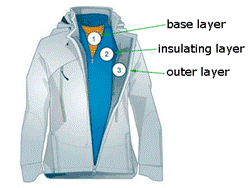Trekking Kit Information
Introduction
The kit list found in your account hub will detail everything that you need to bring with you on your challenge. In the kit list some items are marked as ‘Required’, if you do not bring these items the challenge leader may not let you begin the challenge on the grounds of safety. If the kit is marked as ‘Optional’ or ‘Recommended’ it is your choice whether you bring it or not, these are suggested items that we feel will be of some benefit to you during the challenge. Here are a few of the really important items on the kit list that you should consider investing in:
Clothing
Socks
always wear good quality socks with your boots. Try on your boots with the socks that you will be wearing on the challenge. One thing to remember is that your socks are just as important as your footwear. If they do not fit correctly they can cause just as much discomfort, even if your boots are well fitted.
If you can, spend money on socks that fit perfectly and also work well in the wet. As with your boots go and ask the experts at your local outdoor shop as there are many different types available.
Socks made out of wool or any other natural material are ideal as they are great for drawing moisture away from the skin and are quick drying and therefore less likely to give you blisters. Make sure that they fit you nice and snug and pay particular attention to the areas around the heel and toes. Also, ensure that they don’t slip down whilst you are walking.
One golden rule… you can never have too many pairs of socks. Dirty socks have less cushioning and can cause friction. Changing your socks regularly can really help so take more than you think that you will need.

When walking, it’s always best to adopt a layering system to your clothing. This ensures that you can adapt quickly to the weather and changes to your body temperature.
Base Layer
Your base layer will draw moisture away from the skin. Cotton should be avoided as it holds moisture, takes a long time to dry and can make you cold. Synthetic fibres, such as polypropylene and polyester work the best. Your base layer should be relatively close fitting but still comfortable.
Mid Layer/Insulating Layer
This layer is to help keep you warm, it does this by trapping air between the fibres. Fleece is great at doing this and makes an ideal breathable layer. Some mid layers come with a wind blocking membrane so you can keep the wind out without the need to put an outer waterproof layer on.
Outer Layer
This layer should be a waterproof, breathable jacket with taped seams.

Walking Boots
Your feet are going to be your best friends from now on, so please keep them happy! Your walking boots need to be comfortable and specifically designed for walking. Reasonably high ankle supports on your boots are desirable and a stiff heel counter to give you lateral support is also recommended. It’s always worth investing in a good pair of walking boots and also appropriate socks.
Your feet naturally swell during the day, so it’s advisable to try boots on for size towards the end of the day. This will ensure they will fit when your feet are at their largest. Go and ask the experts too. Your high street will have many outdoor shops where the staff are specifically trained to help you. Try to find a shop that can accurately measure the length and width of your feet, as this will ensure the best fit.
To break in your footwear, start by wearing them for an hour or so every day; wear them around the house to do your cleaning or wear them to go shopping. Fit wearing them into your lifestyle, you may not look fashionable, but it will make such a difference when wearing them on the challenge.
Gradually increase the time that you wear your boots. Once you start wearing them comfortably for a number of hours over consecutive days, you should be ready to start using them for long distance walking.

Equipment
Walking Poles
Walking poles can be very useful as they distribute the weight between your arms and legs. They are particularly helpful when walking long distances as they can reduce the strain on your legs which means you can keep going for that little bit longer. They are also great for extra support when walking up or down steep sections. It’s entirely up to you if you want to use them, just remember to use them in your training if you intend to use them on the challenge.
Backpack/Rucksack
You will definitely need a backpack/rucksack to carry essential items such as extra layers, snacks, camera and personal first aid kit. Getting the fit of your backpack/rucksack right is crucial to ensure that you are comfortable and that the weight is distributed across the shoulders and back. It is a good idea to have a backpack/rucksack that has a waist and chest strap as this keeps it secure and it’s less likely to cause chafing. Your high street will have many outdoor shops where the staff are specifically trained to help you get the correct size and fit.
Mobile Phones
Mobile phones are an essential item. Don’t forget to make sure that your phone is fully charged. We recommend bringing a power bank so you can charge your phone along the route or at the accommodation.
First Aid
Whilst Global Adventure Challenges and our ground handler will provide adequate first aid cover during the challenge all participants are required to bring their own personal first aid kit that includes plasters, blister support etc. so that individuals can deal with minor issues themselves. It is also recommended that participants bring with them a personal supply of over the counter medication such as Paracetamol, Ibuprofen and anti- histamines.







